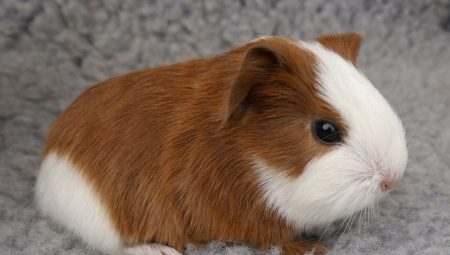Guinea pig is a pet, the acquisition of which every second child begs parents. And often adults do not stubbornly for a long time: not the most troublesome animal, small, cute, and you don’t need to walk. But when a guinea pig appears in the family, the first argument about the pet is whether to bathe it. This is where the controversy begins: the pig is not the most neat animal, it’s obvious that you need to bathe often! Marine - where does she go for a long time without water. Both arguments do not hold water.
The pig was called a beast because of the shape of its muzzle, which was somewhat reminiscent of a pig's stigma. And the general contour of the body fit into the image of a pig, only very small. And “marine” is what remains of the adjective “overseas,” as the animal was originally called. So it’s not possible to consider a pet dirty or a beast from the sea.
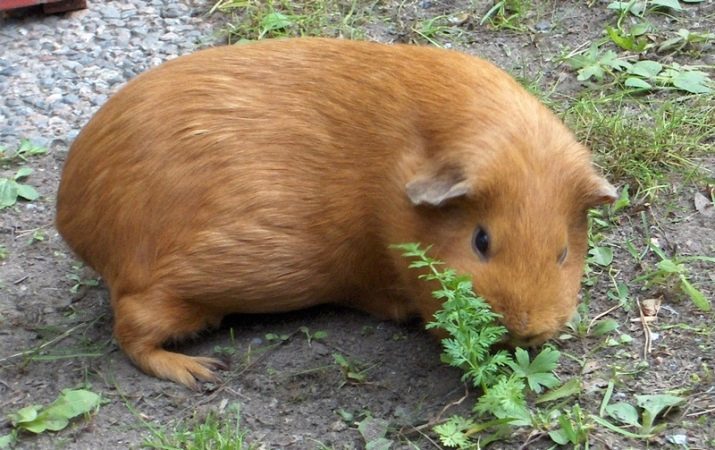
Pros and cons"
The rodent is considered to be a neat animal. Normally, he puts himself in order, and the guinea pig does not need to be washed additionally. In the natural environment, of course, no one arranges water procedures for the animal.
The rodent monitors the wool on its own: licks the tongue as necessary, and then smoothes it with its paws.
If the animal is healthy, if the conditions that you organized for him are favorable, you should not bathe him. For a rodent, water procedures will be stressful: and for children who most often insist on a piggy bath, this should be explained immediately after acquisition.

But there are arguments suggesting that sometimes you still need to wash a guinea pig.
Consider in what situations the animal should be washed.
- If on the wool with his naked eye tangles, lumps, pollution, formed due to various reasons, are noticeable. This can happen to a pig if it “runs away for a walk” or, in the warm season, walks in a street aviary.
- If you see that the pet’s coat has faded, if you can’t call it shiny and lively, then the pig may not be able to wash itself. This also happens. In this situation, she needs help.
- If the next day an important exhibition, where you are going to show your pet in all its glory, the pig needs a bath as a spa. In order for the fur to shine, the animal will have to undergo water procedures.
- If the pig began to smell unpleasant, it must be washed as carefully as possible.
- Pay attention to the condition in which the pig has sebaceous gland. Where the animal has a tail, there is an organ responsible for the production of sebum. And to be more precise, a special secret is made from the gland, which, like pheromones, acts on representatives of the opposite sex. The sebaceous gland is a greasy zone, oily, looking like a small bald spot. And if you find crusts in this place, the guinea pig definitely needs to be bathed.
As you can see, among the reasons for bathing there is no “curiosity”, “idle interest” and reasons like “I think she wants to swim.” Therefore, once again do not stress the animal: the water for him is a frightening situation.
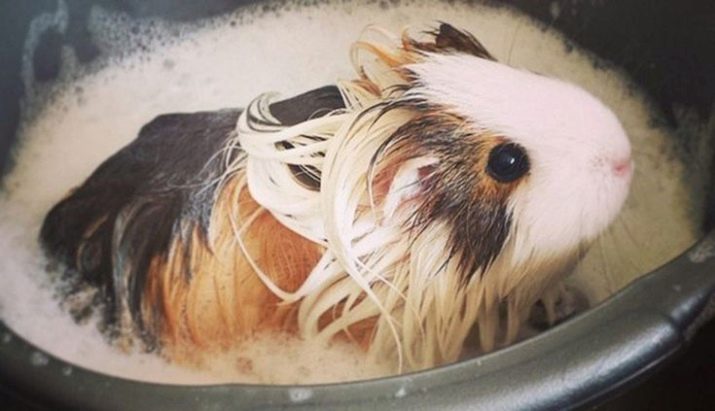
Do they like to swim?
This is not to say that pigs enthusiastically accept the idea of swimming. Yes, animals have swimming skills - in natural conditions they can overcome water barriers (streams, for example). If you bathe an animal, you won’t do much harm to it, but bathing will not cause any pleasant sensations.

If, having immersed the animal in the water, you see panic, aggression, high anxiety of the pet, do not train him, do not accustom to patience - get the animal out of the water. If it seems to you that it is dirty, just wipe the paw, wool with damp, non-fragrant wipes. You can simply moisten a piece of cloth in warm soapy water and wipe the animal - in most cases this is enough.
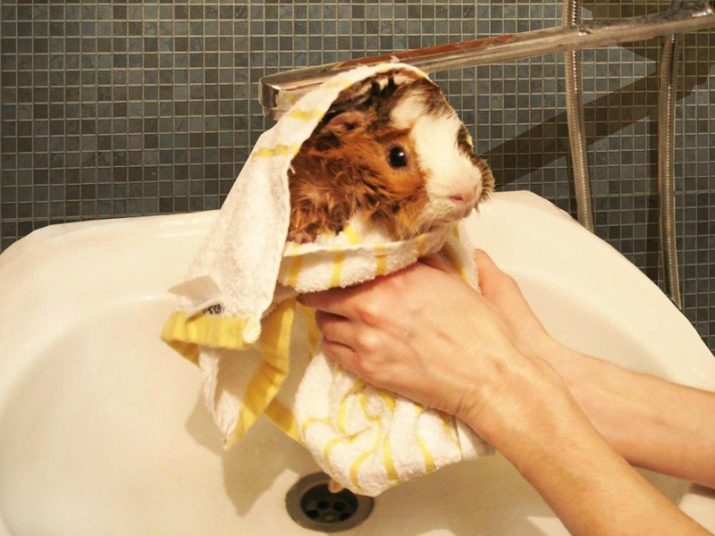
And although most guinea pigs try to avoid swimming, there are instances among their brethren who take a bath with pleasure. If the owners treat them kindly, if the water is comfortable for the animal, it doesn’t pinch its eyes, it’s relaxed and calm, the animal will take a bath well. It may even purr and whistle with pleasure.
But if your animal does not show such emotions, do not try to force him or accustom him to the bath: your activity will frighten him even more.
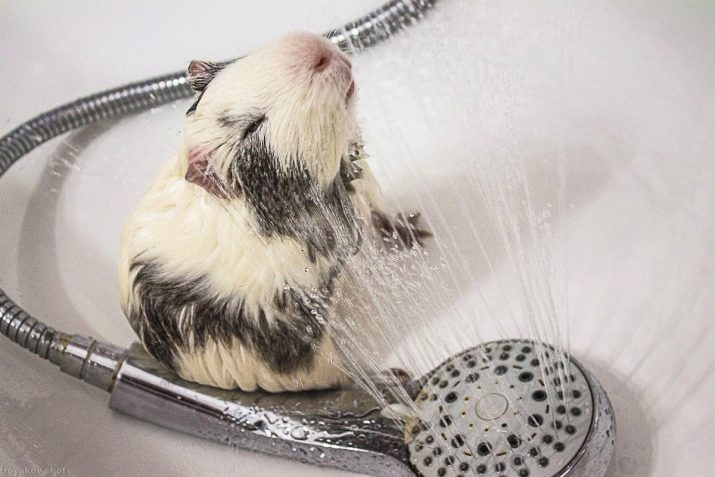
Frequency of procedures
The reasonable question is how many times a month you can bathe a pig. If you have a pet of a long-haired breed, it seems that he only does what he smears, dusts, overgrows with lumps of dirt and so on.
Regular washing is not considered at all - for a mumps this is an unnatural procedure, therefore there is no schedule. If in the summer it is very hot, stuffy, and it seems to you that the pig itself wants to take a bath, then at most once a month you can have a light shower for a short time. At other times, bathe your mumps every 3 months, not more often.
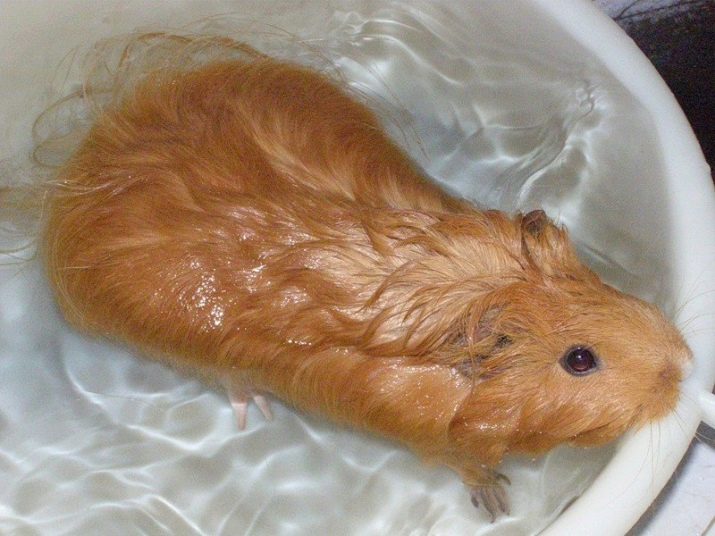
Frequent washing is dangerous for the animal. And the water itself, and especially the soap solution, dry the skin of the animal. Because of this, figuratively speaking, the mumps immunity falls. She becomes susceptible to various diseases.
A person can also catch a cold after a bath, and even a small animal, unaccustomed to natural living conditions, is under direct threat. Because often bathing a rodent is strictly prohibited.
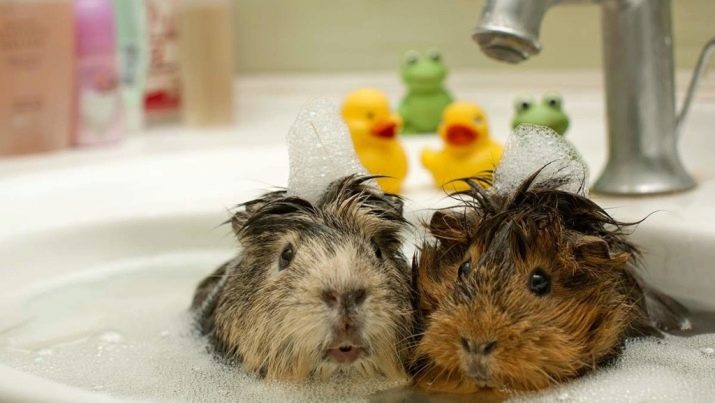
There are at least 5 "no" regarding swimming a guinea pig.
- You can not bathe cubs - only adults tolerate bath procedures relatively calmly. Small guinea pigs are threatened by stresses from all sides, and they may not survive water stress. And the young wool does not need washing.
- You can not bathe a pet in the early days of home. It seems to many owners that the pig must first be bathed so that it is "clean and fluffy" better accustomed. On the contrary, such stress only interferes with the adaptation of the animal. Let him get comfortable, everything is new for him, everything is scary, everything is alien.
- Do not bathe your pet in winter. As already mentioned, a cold can be fatal for a rodent. Mumps are extremely sensitive to temperature extremes and drafts.
- Do not place pregnant females in water: bathing for them is a huge stress with serious risks.
- Do not bathe a sick rodent.
Never violate these rules - one case of neglect is enough to cause irreparable harm to the animal.
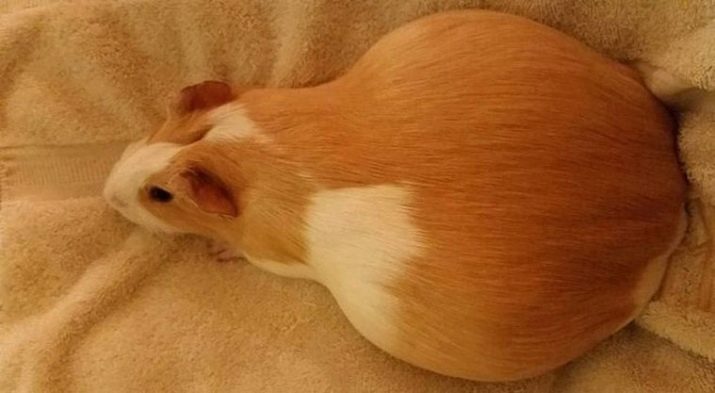
Basic Rules
The animal is afraid of any suddenness. He perceives this as a threat, begins to panic, scream, break free. In this situation, you can’t continue swimming. Therefore, the pet needs to be prepared for the procedure. 3-5 days before the scheduled bathing, you should take a rodent in your hands, go into the bathroom. If he was already afraid at this stage, calm the animal, pet, you can treat your favorite treat.
You can comb out the hair of a pig in the bathroom: most pets love this, because the new environment will be associated with a pleasant feeling in the rodent.
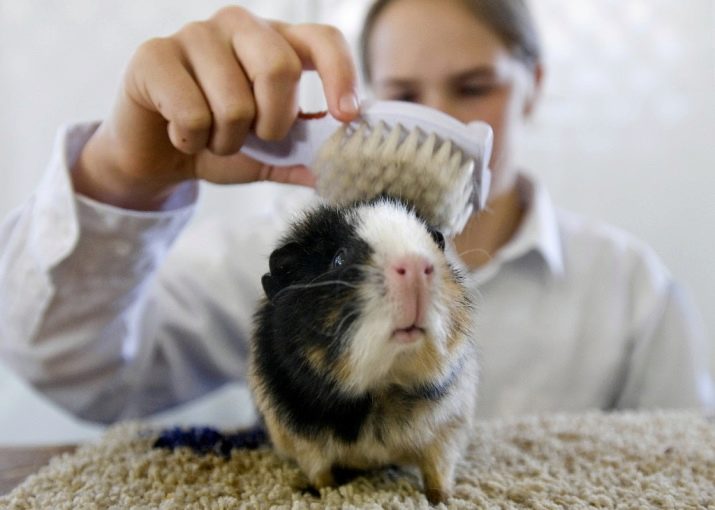
When you understand that the pig has settled in the bathroom, you can put it in the sink or in the basin (where you are going to bathe the animal in the future). Let it get used to the dry surface, so that then it does not react negatively to the same place, only with water.
The next step in safe addiction is to turn on the water. Let the water flow in a thin stream (no strong pressure), do not direct the water to the pig’s hair even as a joke. The animal needs to feel the water with its paws, then it will cease to be afraid of the sound of water.
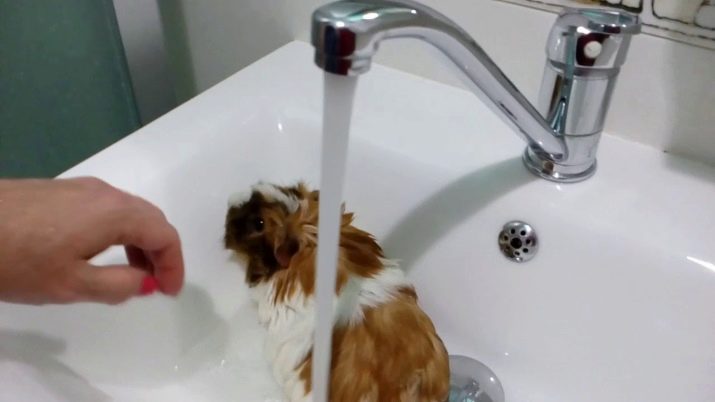
Process description
Do not rush with swimming if you see that the adaptation was not entirely good. Only when the pig stopped being afraid of the bath, when the water flowing from the tap is not afraid of it, can the animal be bathed. The procedure begins still "on land". About 20 minutes before bathing, the animal’s sebaceous glands should be lubricated with cosmetic oil (any one will do). This will soak the crusts, which will allow them to fall off faster and easier in the water.
It is not difficult to wipe the sebaceous gland: drip oil on a cotton pad, gently rub it. Try not to get oil on the pig’s hair.
Be sure to wear gloves before washing. It is possible that the pig will still get scared, start kicking and biting - you need to protect yourself.
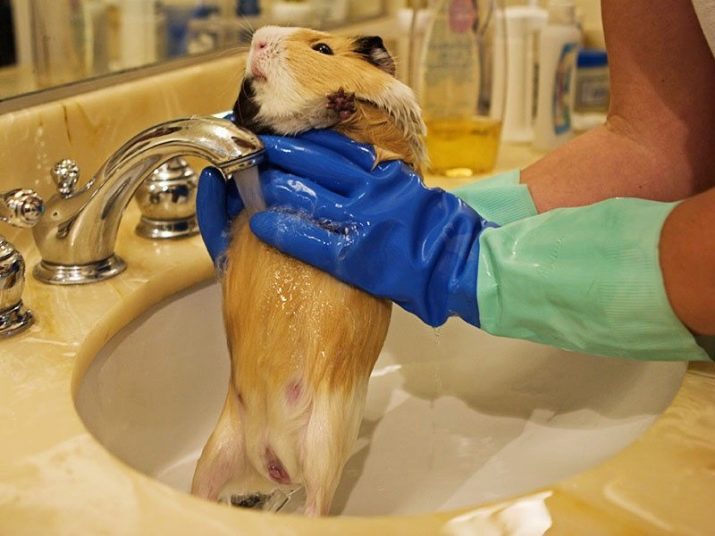
Bathing a guinea pig involves several activities.
- It is more convenient to bathe the animal in the sink. To do this in the bath or in the basin is not very correct: the pig will see the sides and may try to jump out of the tank. And in a soapy solution, the animal is very slippery, so you do not have to rely on your own dexterity. In water, you need to be very careful - if the pig breaks out and falls, it can seriously cripple, there is a threat of mortal danger.
- Close the drain in the sink, draw enough water so that it touches the pig’s tummy evenly. It is reasonable to put a small cotton napkin on the bottom of the sink so that the animal can grab hold of its paws - so the animal will be calmer.
- Dip the pig into the water, stroke it, talk calmly and gently.
- Hands gently moisten the pet's fur. If you have a long-haired pig, you can take a small bucket or a glass, pour a thin stream with water from the bucket of the animal. But do not raise the container very high: the pig will get scared.
- When the coat is already sufficiently moisturized, apply literally a drop of shampoo to your hand (no longer needed). Take the shampoo for children, neutral if there is nothing else. But it is better, of course, to purchase a special tool in a pet store. Shampoos for rabbits and cats are quite suitable, but do not take funds for dogs - they are very aggressive against pigs.Try not to wash the pet with a simple soap, it contains a lot of acids, which makes the coat brittle and stiff.
- Fill the shampoo in the usual way in your hands, apply it on the animal’s hair. Foam should not get on the head, reach no further than the neck. Gently rinse the area of the sebaceous gland with maximum delicacy. Remove the crusts - they are already soft, remove well.
- Start washing the wool, do it slowly, without sudden movements. Water the animal at a time with bucket water. Moisture should not get into the ears and eyes of the mumps. This is fraught with otitis media, conjunctivitis, which will be added to the elemental fear.
- For long-haired pigs, owners often complicate the washing process with the additional use of balm. There is no great need for this, unless, of course, you are preparing the animal for the exhibition. True, after the balm to comb the hair is not so difficult. Hold it for a minute on the wool, rinse. But do not get carried away - every time you don’t have to wash your pet like that.
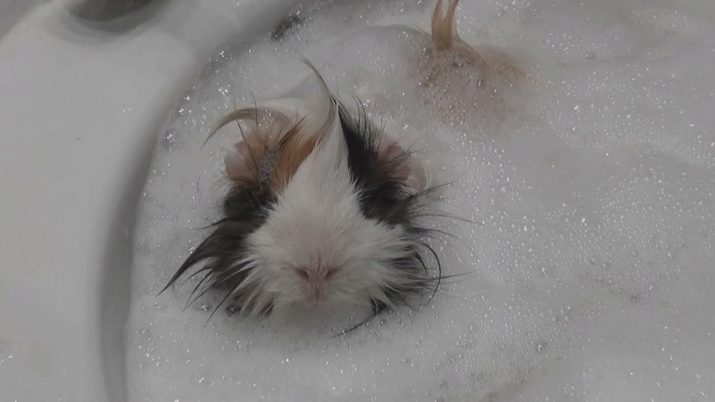
There is nothing complicated in the rules, if you do not ignore a single prescription, then occasionally, if necessary, you can bathe an animal at home. If the first bathing experience has remained positive, this does not mean that the procedure can be increased.
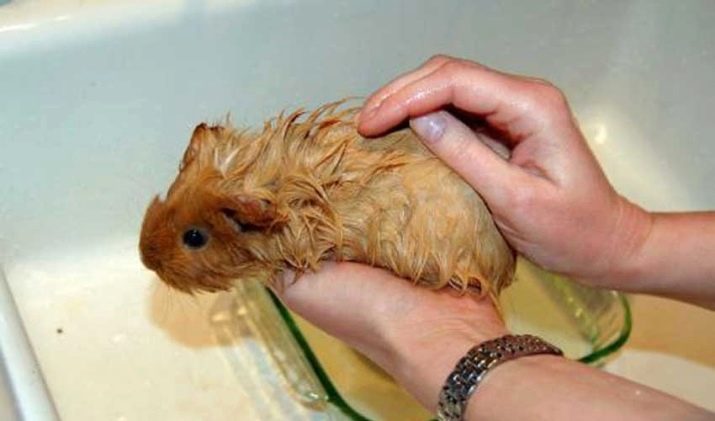
After the bath procedures, once again clean the pig’s sebaceous gland, as well as the anal pocket. Wipe the area of the sebaceous gland with a cotton swab, then treat with an antiseptic (normal chlorophyllipt will do). To clean the anal pocket, you need to slightly press on the lower abdomen of the mumps, the pocket will stick out, with a cotton swab soaked in oil, you will quickly clean it. Avoid unnecessary friction. Very often, manual cleaning cannot be done, but try to do it once a month and a half.
To dry your pet, you can use a hairdryer in delicate mode. But if the pig is afraid of sharp sounds, it is better to refuse to use the device.
If you see that the animal was scared, just use a dry towel, not forgetting to change the fabric.
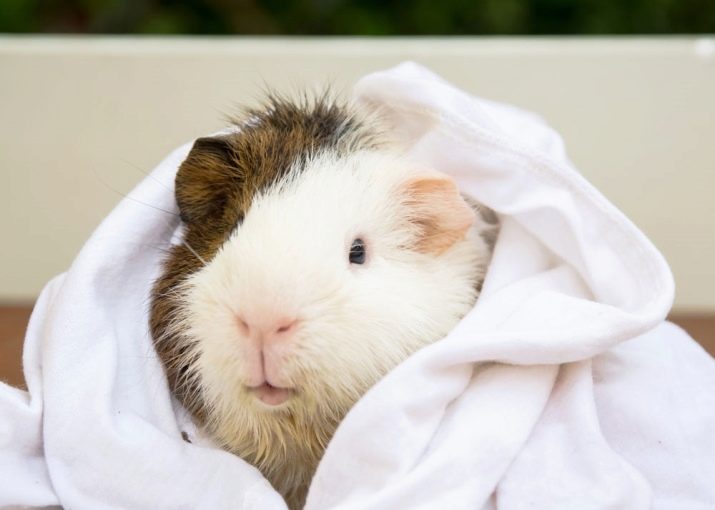
After swimming, you do not need to take the animal out to the street for at least a day. In a cold room, in a draft, you can not leave a rodent. Do not let a wet animal into a cage with sawdust - they will stick to the fur. After the bath, the pet deserves a delicious dinner, please the animal, it is useful for him to calm down.
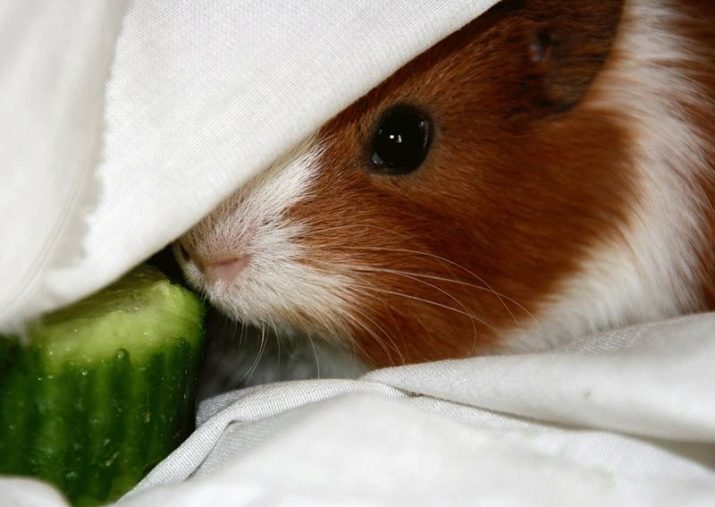
For how to wash a guinea pig, see the next video.
